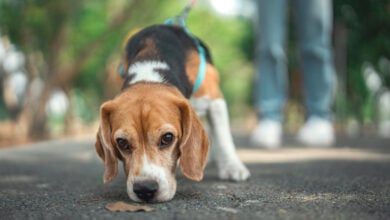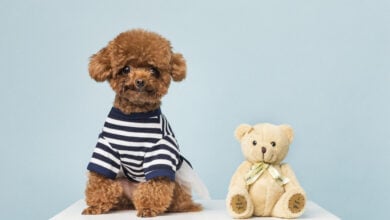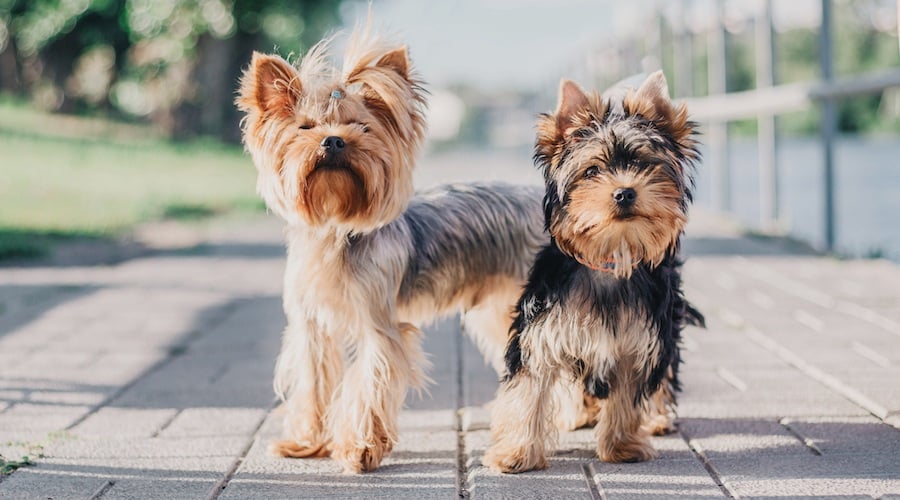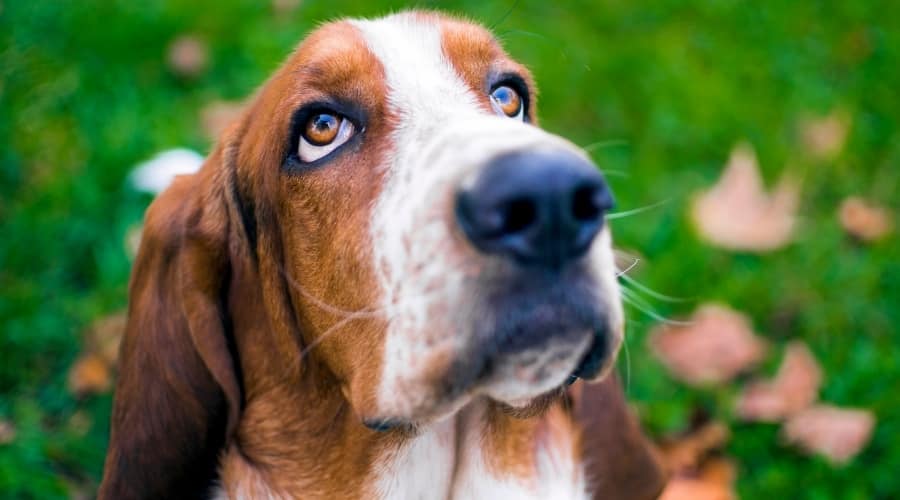These Dog Breeds Look So Much Like Wolves You’ll Do A Double-Take
When you purchase through links on our site, we may earn a commission. Here’s how it works.
Some dogs carry a wildness in their face that makes you look twice. Their thick coats, sharp silhouettes, and steady, watchful eyes feel straight out of the wilderness.
Table of Contents
These wolf-like breeds didn’t get their rugged looks by accident. Many were shaped by icy climates, long-distance work, and ancient survival instincts that still show in their stride. Others were intentionally bred to capture the dramatic wolf aesthetic while keeping a companion-friendly temperament.
If you’re drawn to dogs with a touch of the wild, this list explores the breeds that resemble wolves most, from striking, near-wolf lookalikes to friendly northern dogs with subtler wolfish features.
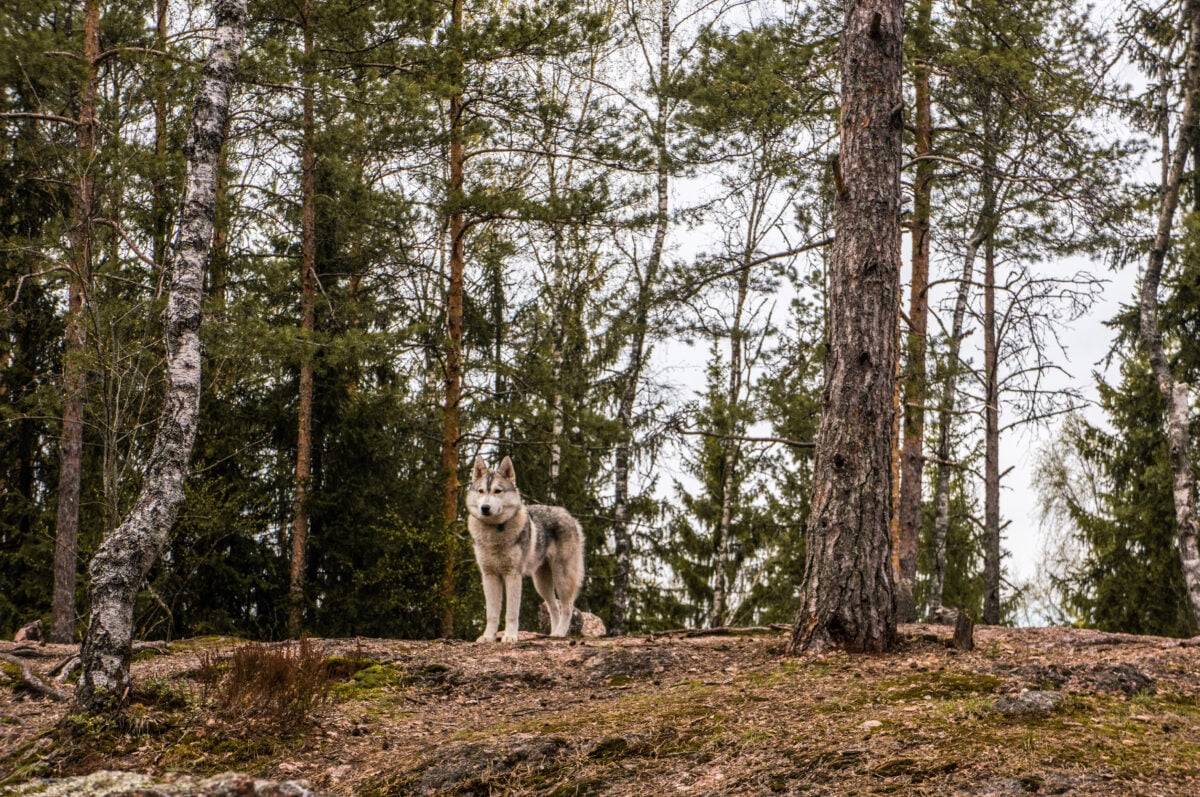
These 19 Wolf-Like Dog Breeds Could Be Your Next Pack Member
These are the dogs people mistake for wolves at a glance. Some resemble their wild cousins so closely that you might double-take on a hiking trail, while others carry subtler wolfish traits shaped by northern climates and working-dog heritage.
To make things easy to explore, the breeds below are grouped by how strongly they resemble wolves, from near-wolf lookalikes to more approachable companions with milder wolf-like features.
Each profile highlights what makes the breed unique, including appearance, temperament, energy needs, and ideal home environments.
Breeds With High Wolf-Like Features
These are the breeds most often mistaken for real wolves. Their long muzzles, upright ears, thick coats, and steady, wild-leaning expressions immediately set them apart from typical domestic dogs.
Some have distant wolf ancestry, while others were selectively bred to capture the dramatic wolf aesthetic. All of them command attention and thrive with active, experienced owners who understand their working instincts and high physical needs.
1. Czechoslovakian Wolfdog
Developed in the 1950s by the Czech military, the Czechoslovakian Wolfdog originated from a cross between German Shepherds and Carpathian wolves. The goal was to create a patrol dog with exceptional stamina, drive, and working ability.
Modern dogs retain only a small percentage of wolf ancestry, but they still reflect the strength and athleticism of their origins.

This breed’s wolf-like look comes from its long, narrow muzzle, upright ears, dense double coat, and bushy tail. Its efficient, ground-covering gait and natural aloofness with strangers further enhance the resemblance.
- Temperament and personality: loyal, independent, reserved with strangers, highly intelligent
- Energy level and exercise needs: extremely high energy, two to three hours of daily activity, thrives with structured training and challenging work
- Grooming requirements: dense, weather-resistant coat with moderate shedding year-round and heavy seasonal shedding
- Care considerations: requires experienced handling, firm consistency, and early socialization
Best for: experienced handlers, adventure-focused lifestyles
2. Saarloos Wolfdog
The Saarloos Wolfdog was created in the 1930s by Dutch breeder Leendert Saarloos, who crossed German Shepherds with European wolves to produce a more naturalistic, wolf-influenced working companion.
Today, the breed retains many traits of its wolf ancestors, including heightened sensitivity, observant behavior, and a strong tendency to avoid unfamiliar situations.

Its wolf-like appearance is unmistakable: a long muzzle, high-set triangular ears, almond-shaped eyes, and a muted coat in natural wolf tones. With a lean frame and fluid, effortless movement, the Saarloos resembles a wild European wolf in both silhouette and expression.
- Temperament and personality: sensitive, gentle, shy with strangers, deeply bonded to familiar people
- Energy level and exercise needs: moderate to high energy, needs daily exercise and mental stimulation, responds best to calm and confident handlers
- Grooming requirements: dense double coat with significant seasonal shedding
- Care considerations: requires gentle socialization, a stable environment, and an experienced owner
Best for: quiet households, confident handlers, owners comfortable with sensitive or primitive breeds
3. Northern Inuit
The Northern Inuit is famous for its striking wolf-like appearance, made even more popular by its role as the “dire wolf” breed on television.
Developed in the United Kingdom using Siberian Huskies, German Shepherds, and other northern breeds, it was intentionally bred to resemble a wolf without relying on wolf content. The result is a dramatic, athletic companion with a gentle, people-oriented temperament.
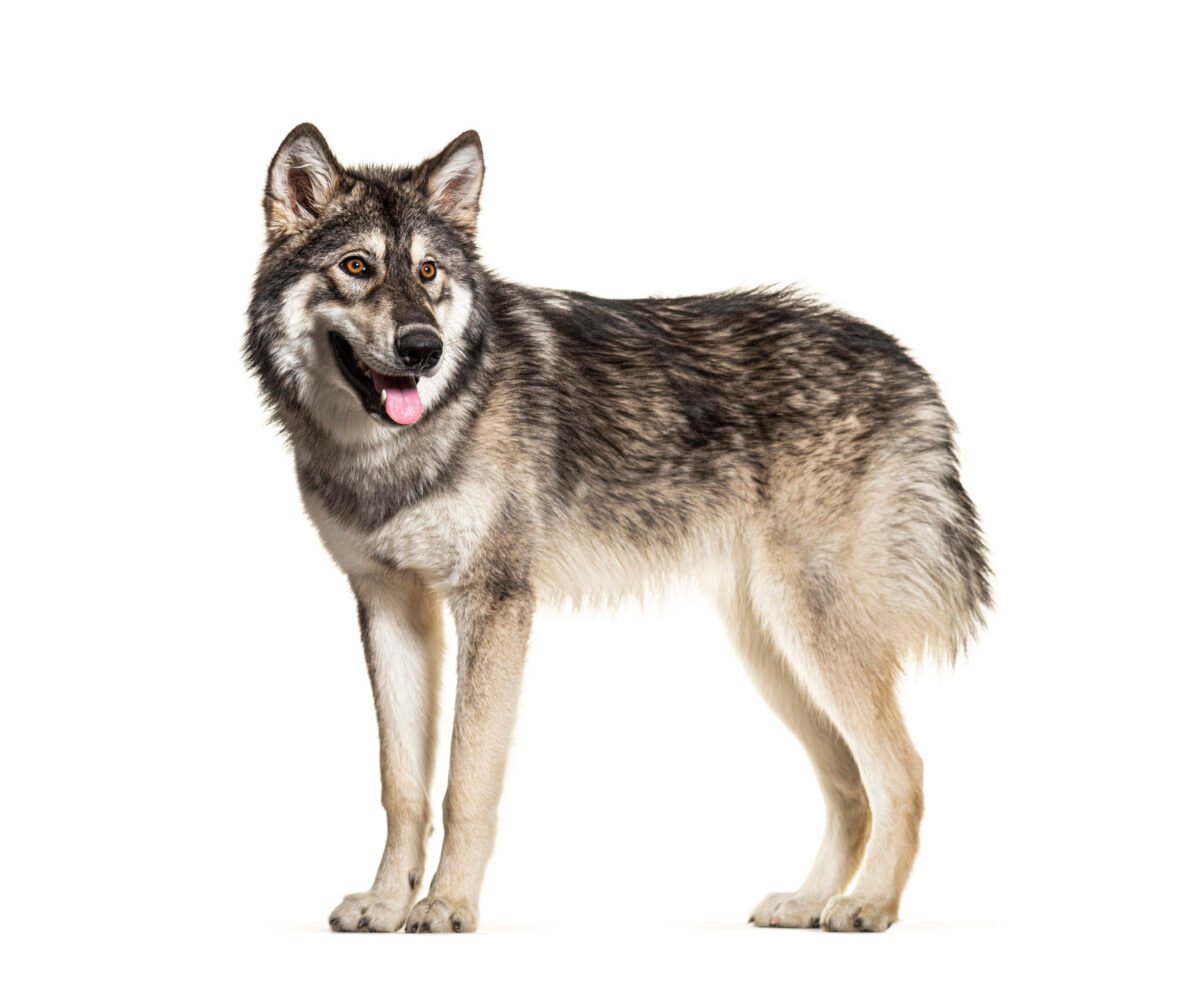
The Northern Inuit Dog has a lean, long-legged build, a broad muzzle, erect ears, and a thick double coat that enhances its wolfy profile. Coloration often includes gray, sable, and black, with facial markings that strongly resemble a wolf’s natural mask.
Fun fact: Northern Inuit Dogs were used to portray the Stark family’s juvenile direwolves in Game of Thrones.
- Temperament and personality: affectionate, social, people-oriented, sensitive
- Energy level and exercise needs: moderate to high energy, needs daily exercise and enrichment
- Grooming requirements: thick double coat with heavy seasonal shedding
- Care considerations: prone to separation anxiety, needs consistent training and companionship
Best for: active households, families wanting a wolf-like but gentle companion
4. Utonagan
The Utonagan was created in the UK as a companion-focused, wolf-resembling dog with a softer temperament than many northern working breeds.
Formed from selective crossings of Siberian Huskies, Alaskan Malamutes, and German Shepherds, this breed aims for the wolf look with a balanced, family-friendly personality. They tend to be slightly more relaxed than Northern Inuits, though individual lines vary.

Utonagans have a dense double coat, upright ears, and a long muzzle that gives them their wolfy outline. Coat colors often include gray, silver, cream, and sable, with feathering and shading that enhance their naturalistic look.
- Temperament and personality: gentle, friendly, intelligent, easygoing
- Energy level and exercise needs: moderate to high energy, enjoys daily walks and outdoor activity
- Grooming requirements: dense double coat with seasonal shedding
- Care considerations: needs routine, early socialization, and regular companionship
Best for: active families seeking a wolf-like dog with a softer, companion-focused temperament
5. Tamaskan
The Tamaskan was developed in Finland, with a foundation of Siberian Huskies, Alaskan Malamutes, and German Shepherds, to produce a wolf-like dog suited for modern companionship and versatile working roles. The result is a rare but steadily growing breed known for its intelligence, trainability, and striking resemblance to a northern wolf.
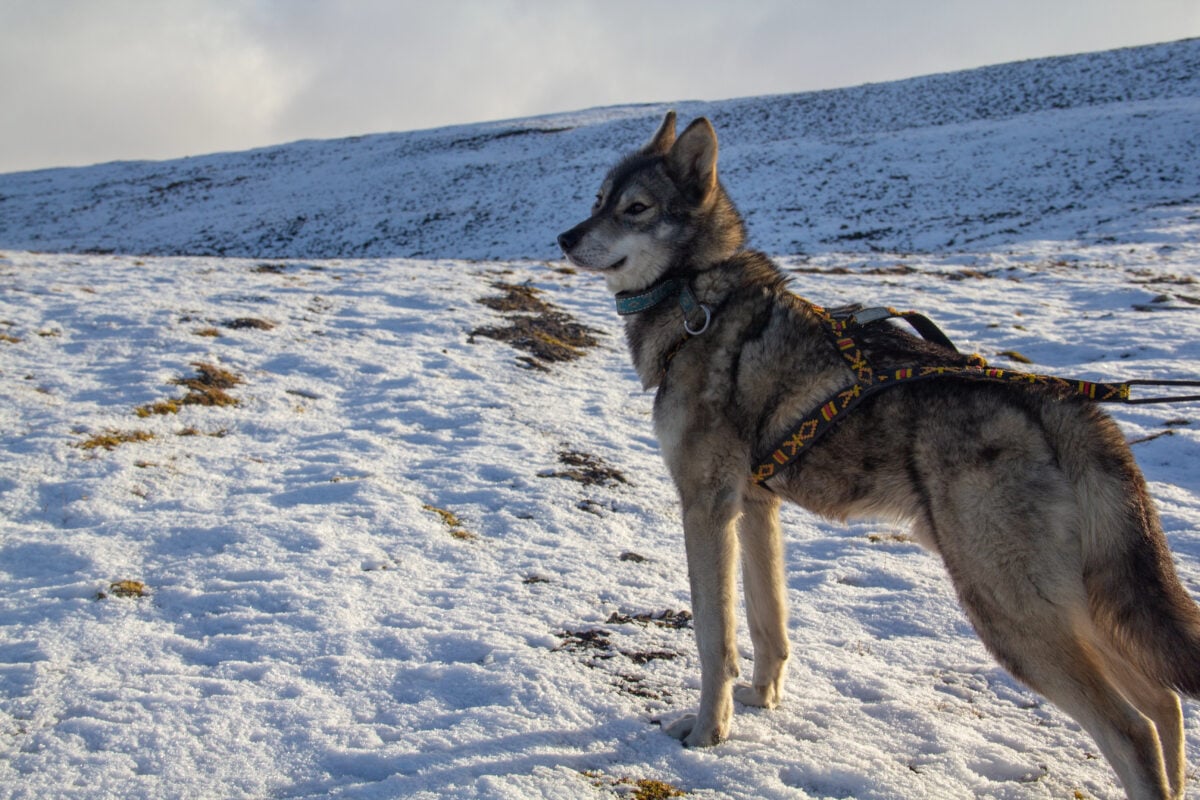
What makes the Tamaskan wolf-like is its long muzzle, deep chest, thick coat, and expressive, almond-shaped eyes. Natural wolf coloring, including shades of gray, red-gray, and black-gray, contributes to the effect.
Fun fact: Tamaska means “mighty wolf” in many Northern American Indian languages.
- Temperament and personality: intelligent, social, eager to please, bonded to family
- Energy level and exercise needs: high energy, excels at long-distance hiking and dog sports, needs daily physical and mental challenges
- Grooming requirements: dense double coat with regular shedding and heavier seasonal blowouts
- Care considerations: requires companionship, does not thrive with long hours alone, needs consistent training and enrichment
Best for: active households, outdoorsy owners, families wanting a wolf-like dog with a cooperative temperament
6. Kugsha
The Kugsha, sometimes called the American Husky, is a rare and somewhat mysterious breed believed to have originated in the United States.
Its exact development is not well documented, but most accounts suggest it was bred for strength, endurance, and load-pulling. This gives the Kugsha a more utilitarian, wolf-adjacent history compared to companion-focused wolf-lookalike breeds.
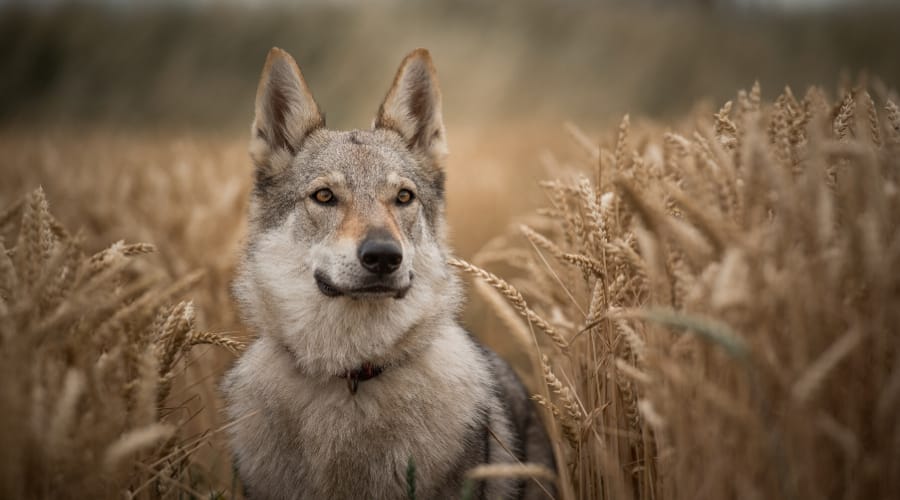
Its wolf-like features include a broad skull, long legs, dense coat, and natural wolf-gray coloration. The body is powerful and slightly longer than tall, resembling wild wolf proportions more closely than many northern breeds.
- Temperament and personality: independent, alert, loyal but not clingy, strong working instincts
- Energy level and exercise needs: very high energy, thrives on physically demanding tasks, needs significant daily exercise
- Grooming requirements: thick double coat with heavy seasonal shedding
- Care considerations: best in homes with space to run, needs a confident and experienced handler, not ideal for apartment living
Best for: highly active, experienced owners who want a rugged, working-style wolf-like dog
7. Greenland Dog
Originating thousands of years ago with the Inuit peoples of Greenland, the Greenland Dog is one of the oldest Arctic sled breeds still in existence. These dogs were essential for transportation, hunting, and survival in extreme polar conditions, valued for their endurance, toughness, and ability to work cooperatively as a team.
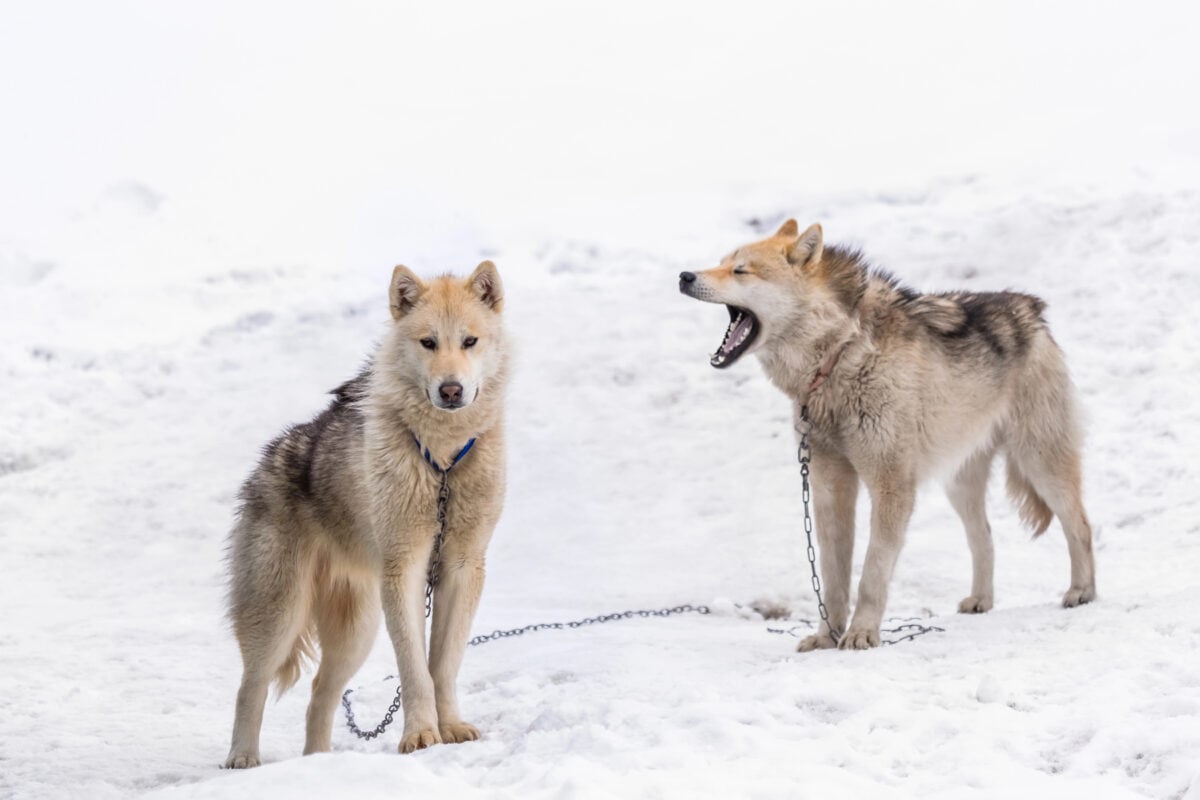
Its wolf-like appearance comes from its broad head, erect ears, strong legs, dense double coat, and alert expression. Their natural colors — gray, sable, black, and white — strengthen the wild-dog aesthetic. Their independent temperament and strong prey drive also echo their ancient heritage.
- Temperament and personality: bold, independent, hardy, pack-oriented
- Energy level and exercise needs: extremely high energy, requires vigorous daily exercise, happiest in working or adventure-focused homes
- Grooming requirements: dense Arctic coat, heavy seasonal shedding
- Care considerations: strong prey drive, needs firm training and early socialization, not suited for hot climates or sedentary homes
Best for: highly active owners, cold-weather environments, and working or outdoor lifestyles
8. West Siberian Laika
Developed in the Ural and West Siberian regions of Russia, the West Siberian Laika was traditionally bred as a hunting dog capable of tracking and treeing a wide range of game. Its primitive ancestry and independent working style contributed to the breed’s natural wolf-like demeanor and build.
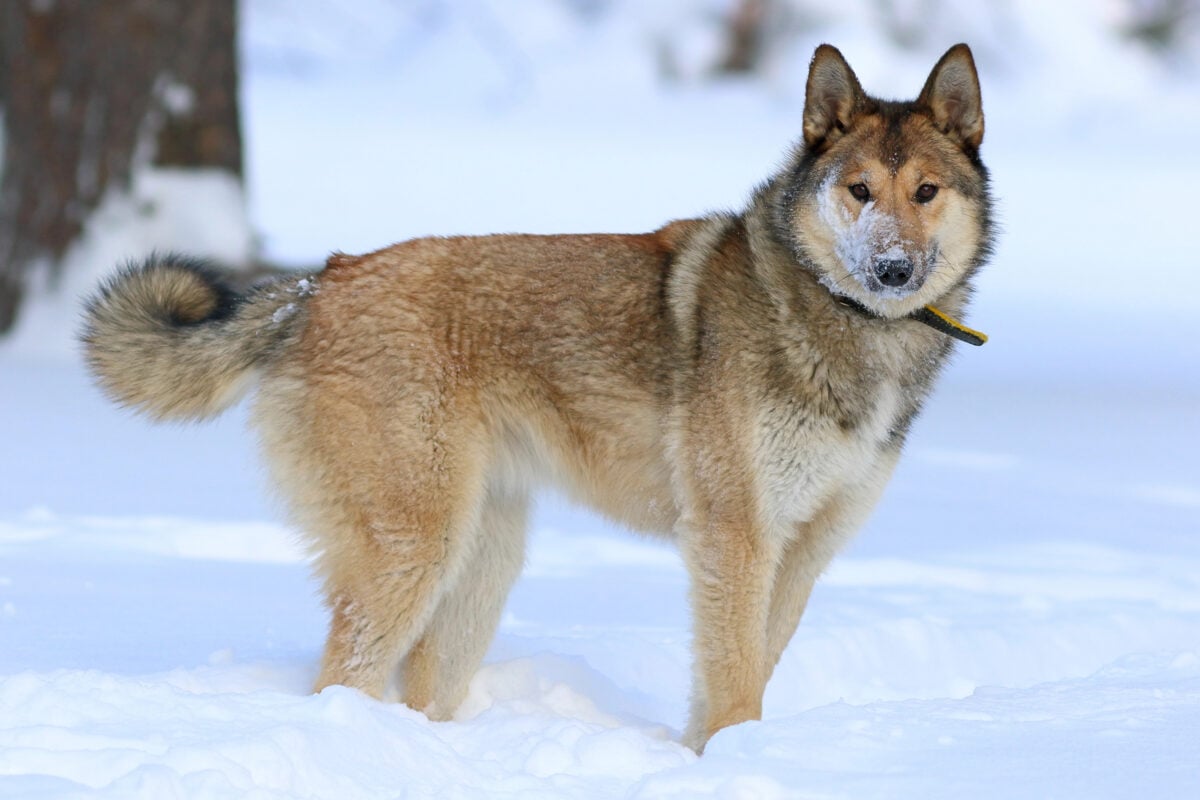
Its wolf-like appearance comes from its wedge-shaped head, erect ears, curled tail, and thick double coat. The breed’s natural instincts — keen senses, high prey drive, and cautiousness with strangers — further mirror traits seen in wild canids.
- Temperament and personality: alert, instinctive, independent, intensely loyal to one person or family
- Energy level and exercise needs: very high drive, needs daily physical and mental work, excels in outdoor activities
- Grooming requirements: dense double coat with heavy shedding during seasonal changes
- Care considerations: strong prey drive, needs early socialization, thrives with experienced owners who appreciate primitive working breeds
Best for: hunters, outdoorsy owners, and experienced handlers seeking a rugged, wolf-like working companion
9. Canadian Eskimo Dog
One of North America’s oldest indigenous breeds, the Inuit developed the Canadian Eskimo Dog for pulling sleds, hunting, and surviving extreme Arctic conditions. Their history is deeply connected to northern Indigenous cultures and traditional working roles.
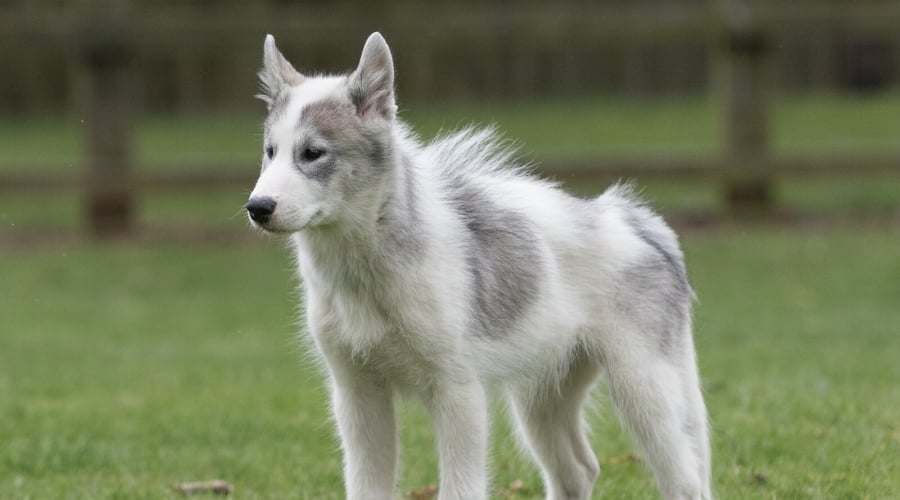
Their wolf-like qualities come from their thick coat, erect ears, strong frame, and keen, alert expression. These dogs were bred for endurance and toughness, giving them a rugged presence reminiscent of Arctic wolves.
Rare breed: The Canadian Eskimo Dog is one of the rarest dog breeds in the world. It’s thought that there are less than 300 left in the world today.
- Temperament and personality: alert, loyal, high-drive working dog
- Energy level and exercise needs: very high energy, thrives on demanding work and long-distance activity
- Grooming requirements: very heavy seasonal coat shedding
- Care considerations: requires substantial outdoor activity, not ideal for inexperienced owners or small living spaces
Best for: highly active, experienced owners who appreciate true working-dog intensity
10. Seppala Siberian Sleddog
Developed from working Siberian Husky lines, the Seppala Siberian Sleddog traces its origins to Leonhard Seppala, a legendary musher known for leading the 1925 serum run to Nome. These dogs were bred for performance rather than appearance, resulting in a leaner, more wolfish working dog compared to show-line Huskies.
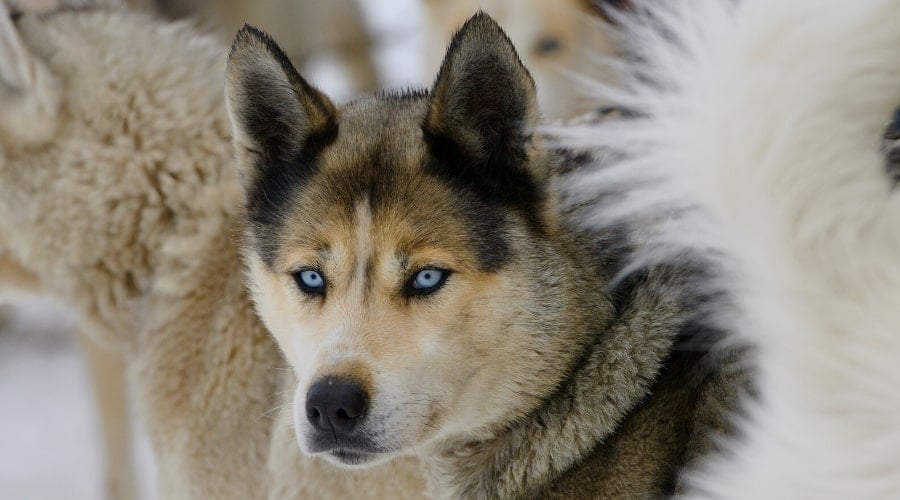
Their wolf-like appearance stems from their narrow heads, upright ears, athletic frames, and natural coloration. Seppalas move with a smooth, efficient trot that’s built for distance, which enhances their resemblance to northern wolf populations.
- Temperament and personality: focused, cooperative, hardworking, gentle
- Energy level and exercise needs: extremely high energy, demands endurance-focused outlets
- Grooming requirements: thick double coat with regular shedding
- Care considerations: best in active working homes, not ideal for novice owners, needs space and structured activity
Best for: mushers, endurance athletes, and highly active owners who enjoy working-style dogs
Breeds With Moderate Wolf-Like Features
These breeds carry noticeable wolf-like features without the intense resemblance found in the previous group. Many come from Arctic or primitive working lines, which give them upright ears, thick coats, and expressive faces that echo their wild relatives.
Their temperaments tend to be more people-oriented, making them excellent companions for active homes that want a wolf-like look with a more traditional domestic personality.
11. Siberian Husky
The Siberian Husky originated in northeastern Asia, where the Chukchi people bred them for long-distance sled pulling in harsh Arctic conditions. These dogs were valued for their endurance, cooperative nature, and ability to work efficiently as part of a team.

Their wolf-like appearance comes from their almond-shaped eyes, erect ears, thick double coat, and graceful, efficient gait. Huskies also share a wolf-like vocal range, known for their howls and “talking” behaviors.
Learn more: Can you spot the differences between the Siberian Husky vs. wolf?
- Temperament and personality: social, outgoing, mischievous, independent thinker
- Energy level and exercise needs: very high energy, requires daily vigorous activity, excels in outdoor adventure
- Grooming requirements: heavy seasonal shedding, regular brushing needed
- Care considerations: strong prey drive, can be escape-prone, needs mental stimulation
Best for: active families, outdoor enthusiasts, owners who enjoy an energetic and social dog
12. Alaskan Malamute
One of the oldest Arctic sled breeds, the Alaskan Malamute was developed by the Mahlemut Inuit to haul heavy loads over long distances. Their strength, endurance, and loyalty made them indispensable working partners in extreme northern climates.
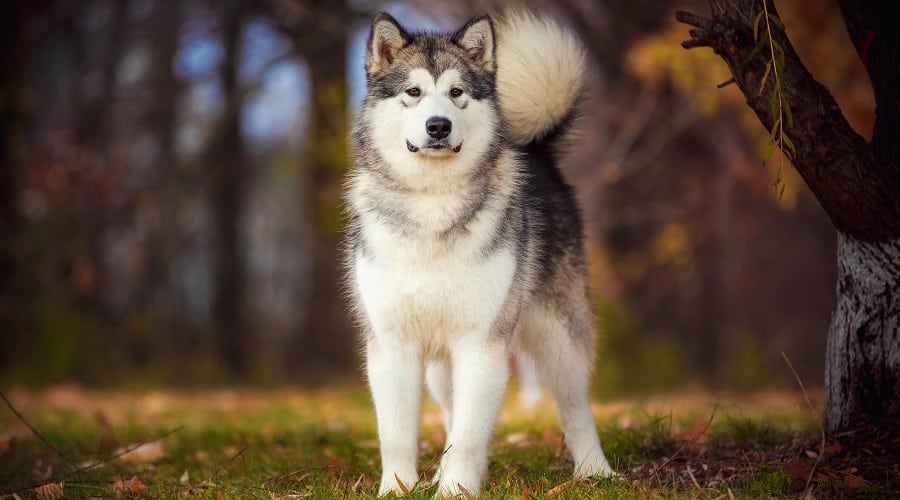
Wolf-like traits include a robust build, broad head, upright ears, and a thick coat in natural wolf-gray shades. Although Malamutes resemble wolves physically, they typically have a much more affectionate and people-oriented temperament, often forming deep bonds with their families.
- Temperament and personality: affectionate, strong-willed, loyal, friendly
- Energy level and exercise needs: high energy, requires daily exercise and structured work
- Grooming requirements: dense double coat with intense seasonal shedding
- Care considerations: can be stubborn, needs confident training, best in cooler climates
Best for: experienced owners seeking a strong, affectionate working dog with a wolf-like look
13. Yakutian Laika
The Yakutian Laika hails from the Sakha Republic (Yakutia) in northern Russia, where it was developed by Indigenous Siberian peoples as a multipurpose sledding, hunting, and herding dog. Its long history as a survival partner in arctic conditions has shaped a highly versatile, intelligent breed.

Though more companion-oriented than some primitive sled breeds, the Yakutian Laika retains many wolf-like features and instincts from its working origins.
Its wolf-like appearance comes from its athletic build, sharp muzzle, triangular ears, and thick double coat, which can withstand freezing temperatures. Their lithe movement and alert posture further enhance their wild-dog appearance.
- Temperament and personality: friendly, intelligent, enthusiastic, highly social with people
- Energy level and exercise needs: high energy, thrives on daily activity, enjoys running, hiking, and problem-solving tasks
- Grooming requirements: thick, weatherproof coat with heavy seasonal shedding
- Care considerations: needs companionship and mental stimulation, can become vocal or restless without activity
Best for: active homes that want a friendly sled-type breed with a wolfish aesthetic
14. American Alsatian
The American Alsatian was intentionally developed in the United States as a companion dog bred to resemble the extinct dire wolf. Founders used breeds such as German Shepherds, Alaskan Malamutes, and English Mastiffs to create a wolf-like appearance paired with a calm, family-oriented temperament.

Wolf-like features include a broad head, thick coat, deep chest, and natural wolf-gray coloration. Unlike many wolfish breeds, the American Alsatian was bred specifically for a gentle, low-energy demeanor, making it far more manageable for the average household.
- Temperament and personality: calm, gentle, steady, people-oriented
- Energy level and exercise needs: moderate energy, enjoys daily walks rather than intense work
- Grooming requirements: thick coat with regular shedding
- Care considerations: thrives on companionship, not ideal for owners who are away for long hours
Best for: families seeking a wolf-like appearance without the high energy or intensity of traditional working breeds
15. German Shepherd
Originally developed in Germany in the late 1800s, the German Shepherd was bred for herding, guarding, and versatile working roles. Their intelligence, trainability, and physical capability quickly made them one of the world’s most popular working breeds.
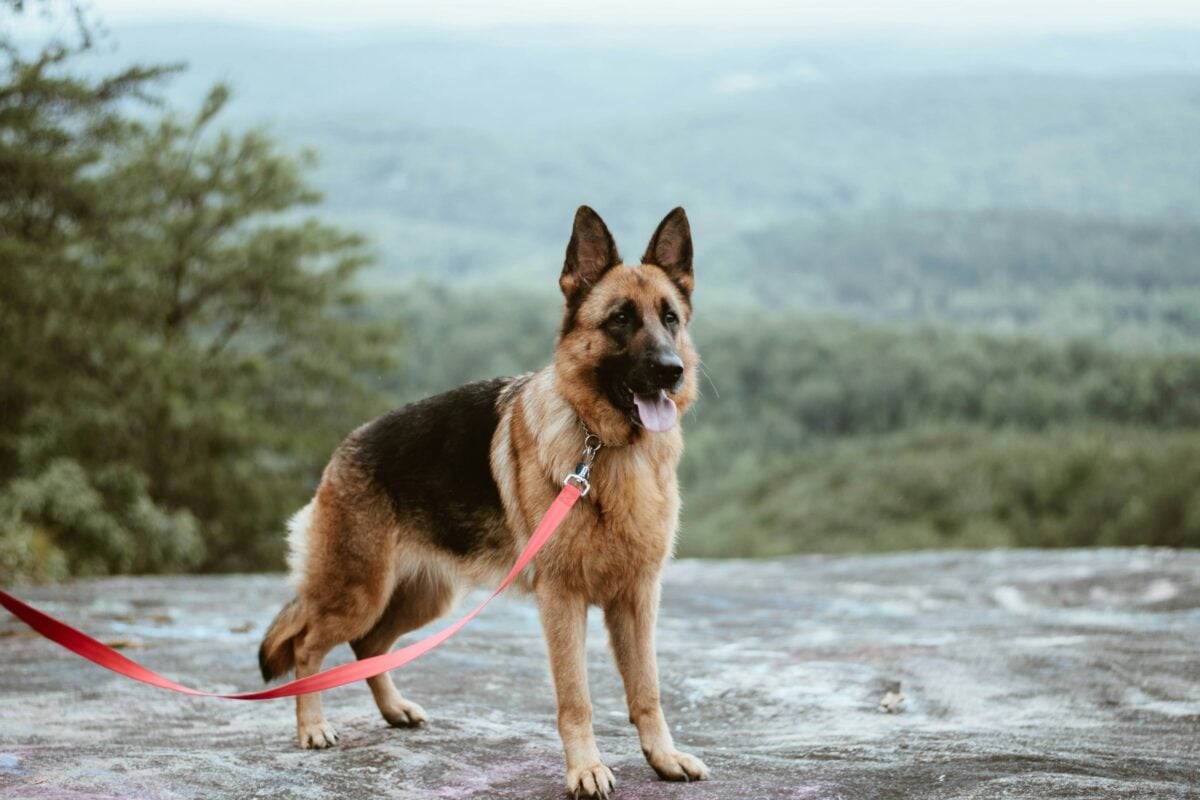
Their wolf-like impression comes from their upright ears, strong muzzle, athletic frame, and confident, steady posture. Their alert expression and fluid movement also echo the look of a wild canid.
- Temperament and personality: loyal, confident, highly trainable, protective
- Energy level and exercise needs: high energy, needs daily physical and mental work
- Grooming requirements: dense double coat with steady shedding
- Care considerations: requires structure and training, prone to hip and elbow issues in some lines
Best for: active households, working roles, owners seeking a versatile companion with a hint of wolf-like presence
Breeds With Subtle Wolf-Like Features
These breeds do not closely resemble wolves at first glance, but they carry certain wolf-like traits in their expression, coat texture, silhouette, or behavior. Many come from ancient working or herding lines, which influences their upright ears, athletic builds, and alert postures.
Their temperaments tend to be more approachable and versatile, making them excellent companions for households that want a hint of wolfish style without the intensity of the more wolf-forward breeds.
16. Finnish Lapphund
The Sámi people developed the Finnish Lapphund for herding reindeer across northern Scandinavia. Their resilience, intelligence, and friendly nature made them invaluable working partners in cold environments.
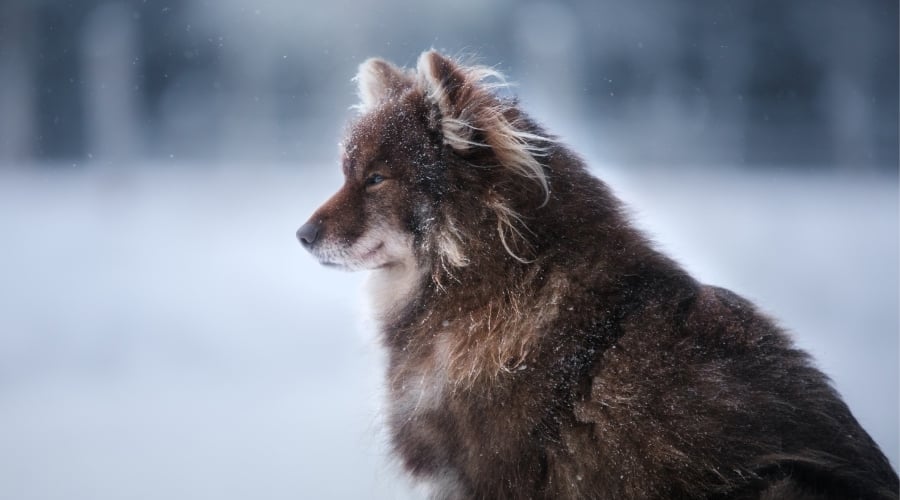
Wolf-like traits appear in their expressive eyes, curled tail, thick double coat, and natural wilderness coloring. Their alert posture and agility add to the subtle resemblance.
- Temperament and personality: friendly, eager, intelligent, alert
- Energy level and exercise needs: moderate energy, enjoys outdoor activities and training
- Grooming requirements: very dense coat with heavy seasonal shedding
- Care considerations: thrives with companionship, needs regular brushing, may vocalize frequently
Best for: active families wanting a friendly, social companion with northern, wolf-adjacent charm
17. Shiloh Shepherd
The Shiloh Shepherd was created in the late 20th century from German Shepherds and Alaskan Malamutes, aiming for a calmer temperament and improved structural soundness. They are known for their gentle, steady nature.
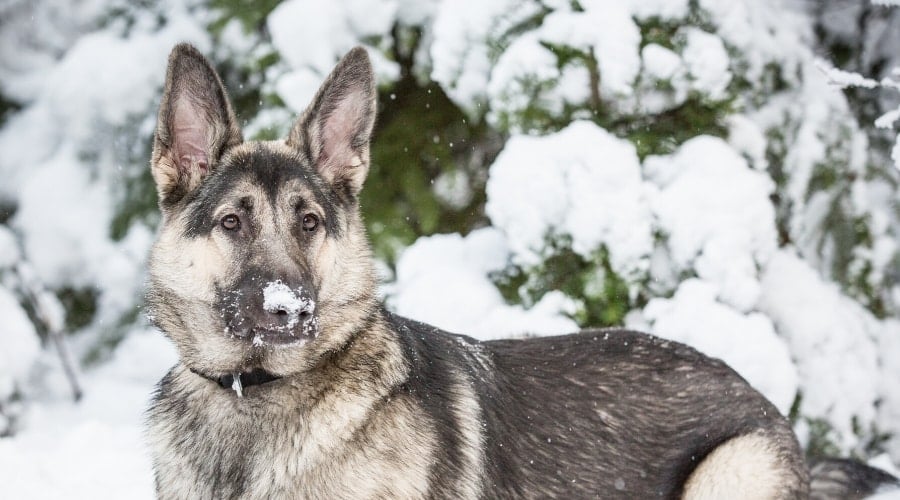
Wolf-like features include their upright ears, long muzzle, thick coat, and substantial frame. Their movement and alert expression give a subtle wild-dog impression without the intensity of more primitive breeds.
- Temperament and personality: calm, intelligent, gentle, deeply bonded to family
- Energy level and exercise needs: moderate to high energy, enjoys long walks and enrichment
- Grooming requirements: dense coat with regular shedding
- Care considerations: needs companionship, responds well to gentle training, can be sensitive
Best for: families and owners wanting a softer, calmer alternative to the German Shepherd with mild wolfish traits
18. King Shepherd
Developed in the United States from German Shepherds, Alaskan Malamutes, and other large working breeds, the King Shepherd was created to be a larger, more stable, and family-oriented companion.
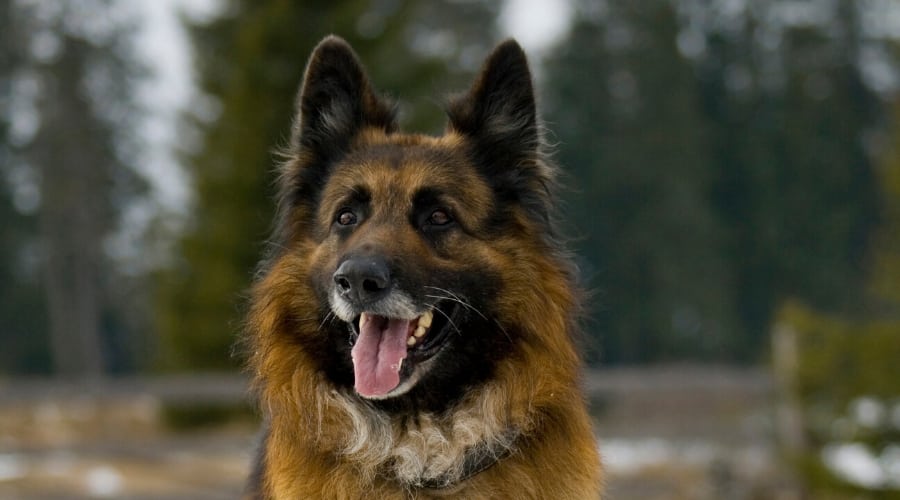
Wolf-like elements include their upright ears, strong muzzles, thick coats, and confident stances. Their overall appearance is reminiscent of a larger, more robust German Shepherd with softened, approachable features.
- Temperament and personality: gentle, stable, devoted, good with families
- Energy level and exercise needs: high energy, needs daily outings and mental stimulation
- Grooming requirements: thick double coat with regular shedding
- Care considerations: requires socialization and training, may be prone to large-breed joint issues
Best for: families seeking a large, steady, versatile companion with a wolfish look
19. Swedish Vallhund
An ancient Scandinavian herding breed, the Swedish Vallhund dates back over a thousand years and shares its early history with Viking culture. Despite their shorter legs, Vallhunds are agile, rugged, and competent working dogs.
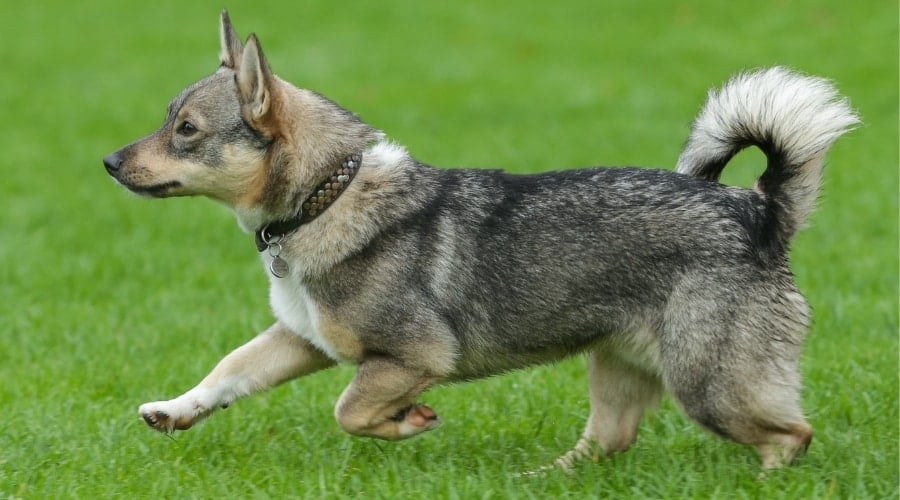
Their wolf-like nature shows in their wedge-shaped head, erect ears, expressive eyes, and natural coat coloring. Their alert posture and confident movement give them a subtle wild-dog charm.
- Temperament and personality: bold, energetic, playful, confident
- Energy level and exercise needs: high energy, needs daily activity and mental work
- Grooming requirements: medium-length double coat with regular shedding
- Care considerations: can be vocal, needs structured training, thrives with active owners
Best for: energetic owners wanting a small but rugged dog with subtle wolfish appeal
History & Ethics of Wolf-Like Dogs
Wolf-like dogs have fascinated humans for centuries. Some breeds developed naturally in Arctic or forested regions, where harsh conditions favored endurance, thick coats, and sharp instincts. Others were created more intentionally, combining domestic dogs with wolves or selectively breeding dogs that displayed lupine traits.
Where These Breeds Come From
Arctic working lines like the Greenland Dog, Yakutian Laika, Siberian Husky, and Alaskan Malamute evolved as vital partners in transport, hunting, and survival. Their wolf-like appearance isn’t engineered. It’s the product of centuries of living and working alongside Indigenous communities in extreme climates.
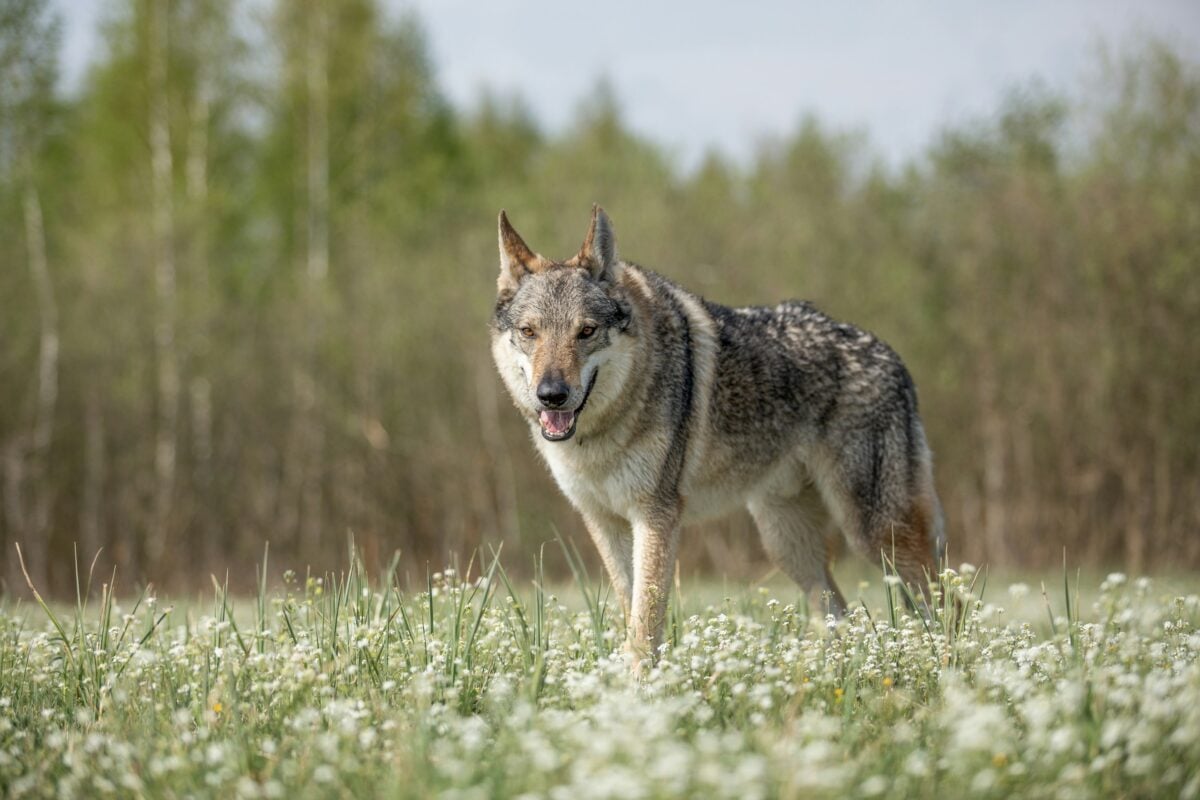
Modern “wolfdog” breeds, such as the Czechoslovakian Wolfdog and Saarloos Wolfdog, have documented origins in the 20th century, when breeders paired German Shepherds with wolves to create highly driven working dogs.
Later “wolfy aesthetic” breeds, including the Tamaskan or Northern Inuit, were developed without recent wolf input. Instead, they rely on selective breeding among domestic dogs to capture the look without introducing wolf behavior.
The Ethics Of Wolf-Like Breeding
Ethics vary widely depending on the breed and its purpose.
1. True Wolfdogs Raise Significant Concerns
Breeding dogs with recent wolf ancestry creates animals that are often:
- more reactive
- harder to train
- prone to stress in domestic environments
- illegal or restricted in many regions
Most welfare experts do not recommend wolfdog ownership for the general public.
Watch: Thinking about a true hybrid? Watch this first! 10 reasons not to get a wolfdog — honest, hard truths any hopeful owner should know.
2. Purpose-Bred Working Dogs Deserve Respect
Breeds like the Greenland Dog, Laikas, and sledding lines were never created as pets. Their continued breeding supports traditional Arctic cultures and working purposes.
Ethical concerns arise only when these dogs are bred or sold without acknowledging their intense needs.
3. “Wolf-Aesthetic” Breeds Are Typically Ethical When Done Transparently
Breeds like the Tamaskan or Utonagan use domestic dog genetics to achieve a wolf-like appearance.
Ethical practices depend on:
- avoiding inbreeding
- transparency about lineage
- stable temperaments suitable for companion homes
4. Marketing Can Be Misleading
Some breeders exaggerate how “wolfy” a dog is, or imply that owning one is an edgy lifestyle choice. Responsible programs make it clear that these are high-energy working dogs, not fashion accessories.
Why Understanding History Matters
Knowing how each breed developed helps set realistic expectations. A dog shaped by centuries of pulling sleds or guarding reindeer won’t behave like a Golden Retriever.
Wolf-like breeds often need:
- strong leadership
- structured training
- daily outlets for mental and physical energy
Understanding their origins isn’t just interesting; it protects both the dog and the owner.
Training & Socialization Tips for Wolf-Like Breeds
Wolf-like dogs may look wild, but living with one shouldn’t feel like taming a wild animal.
These breeds often carry traits like independence, intelligence, and prey drive that require thoughtful training from the very beginning. The right approach builds confidence, strengthens your bond, and helps these striking dogs thrive in a modern home.
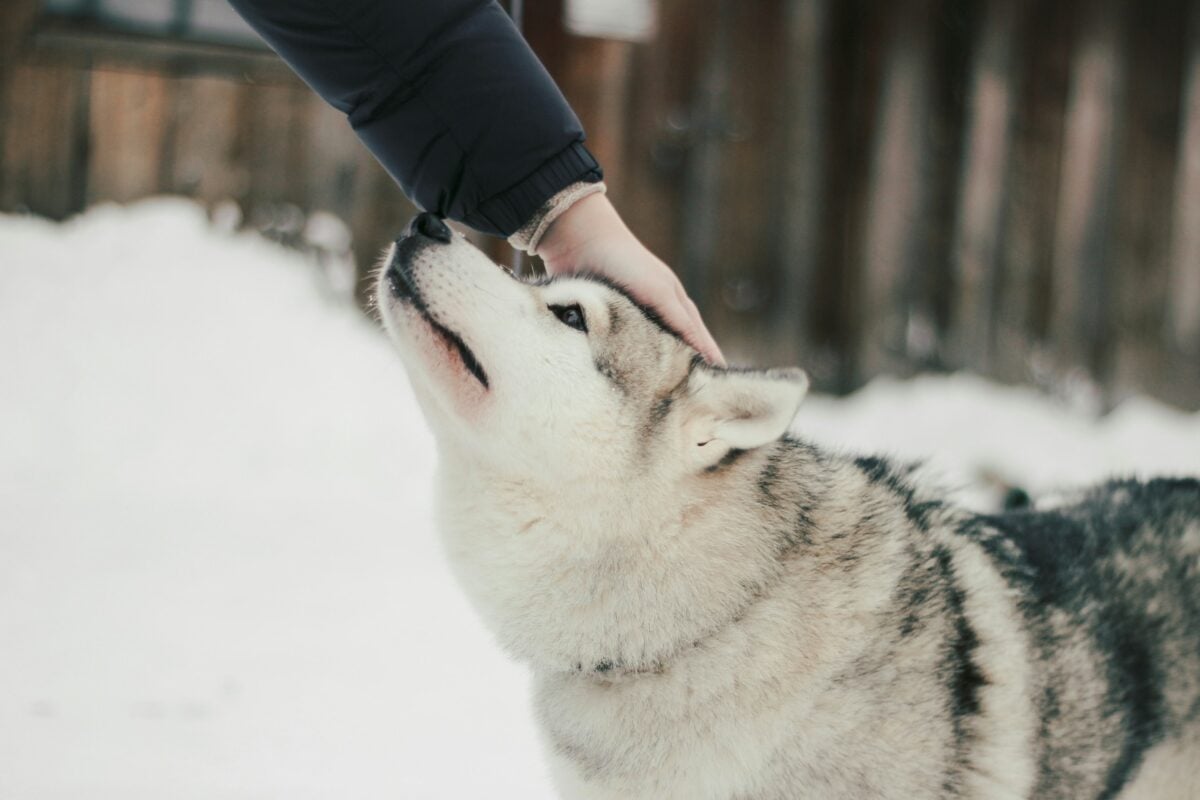
Why Early Training Matters
Starting training in puppyhood sets the foundation for a stable, well-adjusted adult dog. Many wolf-like breeds retain instincts that need early shaping.
Early training helps:
- establish boundaries and prevent stubborn or independent behaviors
- build trust and reduce anxiety in sensitive or reserved breeds
- manage prey drive and territorial instincts
- create a predictable structure that high-drive dogs rely on
- reduce fear-based reactivity through positive exposure
Key timeline: Begin socialization around 8 weeks and continue steadily through adolescence.
Working With High-Energy, Pack-Oriented Breeds
Breeds like the Siberian Husky, Tamaskan, Czechoslovakian Wolfdog, and Greenland Dog were built for endurance and decision-making. Without outlets, they become bored, destructive, or escape-prone.
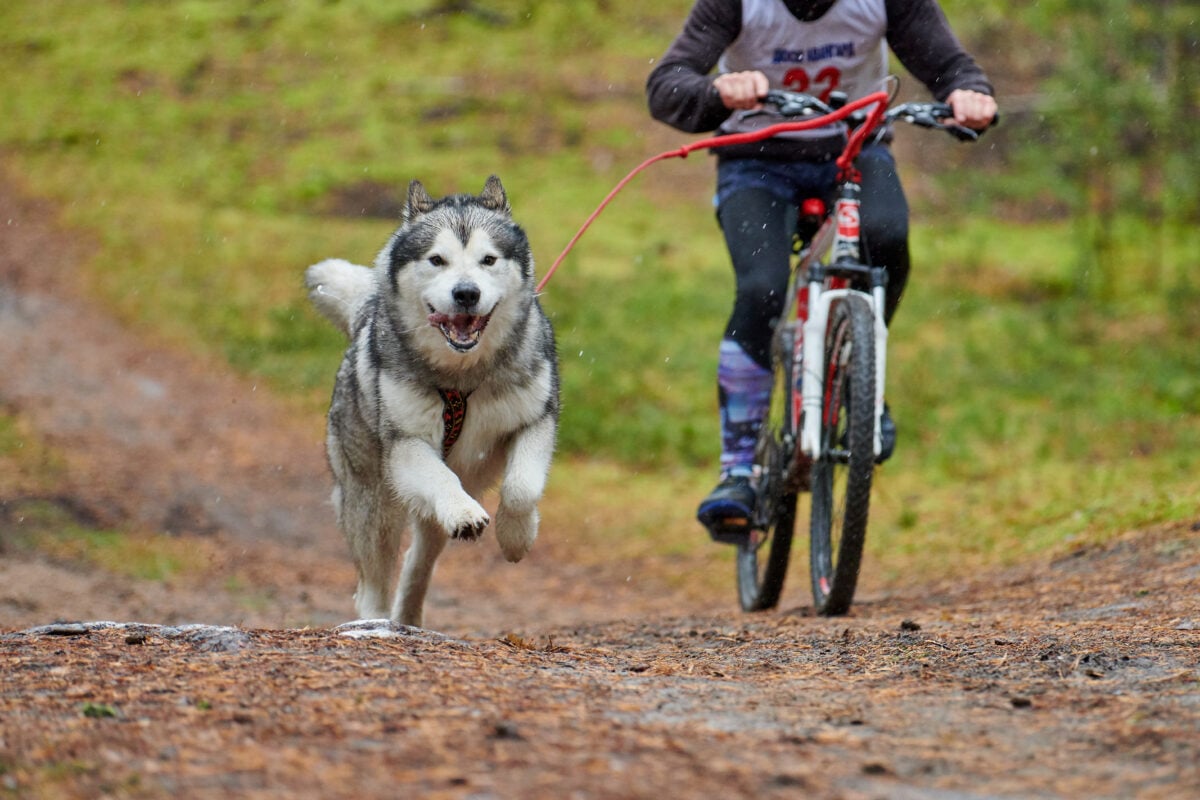
Helpful activities include:
- daily aerobic exercise (long walks, running, canicross)
- dog sports such as agility, tracking, or bikejoring
- structured obedience sessions
- scent work or enrichment puzzles
- supervised pack-style play with appropriate dogs
- rotating “jobs,” not just repeating the same routine
Tip: A tired mind + tired body = a much easier companion.
Training For Independent Or Reserved Breeds
Wolf-like temperament often means:
- slow-to-warm-up personalities
- a natural distrust of strangers
- high environmental awareness
Set your dog up for success by:
- using positive reinforcement, not force
- introducing new people and places gradually
- practicing calm leash walking before tackling busy areas
- building confidence through predictable routines
- avoiding dog parks until training foundations are solid
Advice for First-Time Owners
Not all wolf-like dogs are ideal beginner breeds. Some require advanced management, consistency, and a long-term training plan.
Breeds not ideal for beginners:
- Czechoslovakian Wolfdog
- Saarloos Wolfdog
- Kugsha
- Greenland Dog
- West Siberian Laika
More beginner-friendly options:
- German Shepherd (from stable working lines)
- Finnish Lapphund
- King or Shiloh Shepherd
Before committing, ask yourself:
- Is my home secure enough for breeds known to jump, dig, or climb?
- Can I provide daily high-intensity activity?
- Do I have time for structured training and socialization?
- Am I comfortable with a dog that may be aloof or strong-willed?
Responsible Ownership Starts Here
Wolf-like dog breeds are captivating for a good reason: their striking appearance, intelligence, and loyalty echo the spirit of their wild ancestors. But with that beauty comes responsibility.

These dogs are often misunderstood, misidentified, or unfairly labeled as aggressive due to their wolfish looks. As a potential or current owner, it’s your job to shift that narrative through proper training, socialization, and care.
Whether you’re drawn to a Husky, Tamaskan, or Saarloos Wolfdog, remember that these are not fashion statements; they’re intelligent, sensitive animals that require leadership, structure, and lifelong commitment.
Do your research. Respect their instincts. Train with patience. And above all, be the kind of owner who elevates the reputation of these incredible breeds.
Ready To Find The Right Wolf-Like Dog For Your Pack?
Explore the breeds above, read real owner experiences, and check local regulations before choosing. Responsible ownership starts with informed decisions, start yours today.
Frequently Asked Questions
Choosing a wolf-like dog breed comes with plenty of questions, especially when it comes to behavior, legality, grooming, and ownership challenges. Below, we’ve answered the most common and important questions to help you make an informed, confident decision before bringing one of these majestic dogs into your life.
If we missed yours, or you have experience to share, respond in the comments.
What Is The Most Wolf Like Dog Breed?
The most wolf-like dog breed is the Wolfdog hybrid, a cross between a wolf and a domestic breed like a Siberian Husky or Alaskan Malamute.
These animals are controversial and not considered domesticated in the traditional sense. Wolfdogs require expert-level care and are not recommended as pets for the average dog lover.
Are There Wolf-Like Dog Breeds That Don’t Shed?
Unfortunately, no. Wolf-like dog breeds are known for their thick, double-layered coats, which are built for harsh weather and come with significant shedding.
How Can You Tell If a Dog Has Wolf Ancestry?
Physical appearance can hint at wolf heritage — such as a long muzzle, upright ears, and amber eyes — but the only reliable method is a DNA test. Companies like Embark or Wisdom Panel offer canine genetic testing that can detect wolf content and hybrid ancestry.
Do Wolf-Like Dog Breeds Howl?
Yes, many do. Breeds with northern or primitive roots (e.g., Huskies, Malamutes, Tamaskans) are prone to howling, especially when left alone or when they hear sirens, music, or other dogs.
It’s part of their communication instincts, and it’s something owners should be prepared for.
What Should I Feed a Wolf-Like Dog Breed?
These breeds often have high protein needs due to their energy levels and working backgrounds. A diet rich in animal protein (30% or higher), healthy fats, and joint-supporting supplements like glucosamine is ideal.
Some owners opt for raw diets, but it’s best to consult a veterinarian or canine nutritionist.
Do These Breeds Do Well in Hot Climates?
Most wolf-like breeds were developed for cold or temperate climates, and many struggle in heat due to their dense double coats.
If you live in a warm region:
- Provide constant shade and water
- Limit exercise to early morning or evening
- Consider trimming—not shaving—the coat
Not Just Wolves: What About Fox or Coyote-Like Dogs?
While wolf-like dog breeds get most of the spotlight, some pups resemble other wild canines too.
Fox-like dogs tend to have smaller, agile frames and bright red or fawn coats. Coyote-like breeds often have leaner bodies, longer legs, and alert expressions. Our guides to dogs that look like coyotes and fox-like dog breeds explain more.

